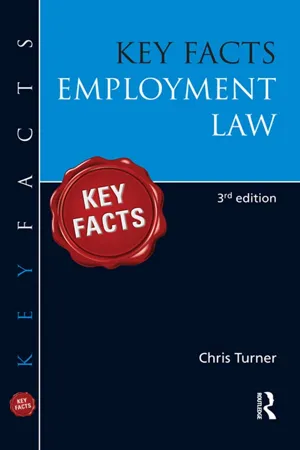
- 154 pages
- English
- ePUB (mobile friendly)
- Available on iOS & Android
eBook - ePub
Key Facts: Employment Law
About this book
Key Facts is the essential series for anyone studying law, including LLB, ILEX and post-graduate conversion courses. Key Facts provides the simplest and most effective way for you to memorise and absorb the essential facts needed to pass your exams. Key Features:
* User-friendly layout and style
* Diagrams, charts and tables to illustrate key points
* Summary charts at a basic level, followed by more detailed explanations to aid revision at every level Additional high-quality revision material is provided on the interactive website www.unlockingthelaw.co.uk
Frequently asked questions
Yes, you can cancel anytime from the Subscription tab in your account settings on the Perlego website. Your subscription will stay active until the end of your current billing period. Learn how to cancel your subscription.
No, books cannot be downloaded as external files, such as PDFs, for use outside of Perlego. However, you can download books within the Perlego app for offline reading on mobile or tablet. Learn more here.
Perlego offers two plans: Essential and Complete
- Essential is ideal for learners and professionals who enjoy exploring a wide range of subjects. Access the Essential Library with 800,000+ trusted titles and best-sellers across business, personal growth, and the humanities. Includes unlimited reading time and Standard Read Aloud voice.
- Complete: Perfect for advanced learners and researchers needing full, unrestricted access. Unlock 1.4M+ books across hundreds of subjects, including academic and specialized titles. The Complete Plan also includes advanced features like Premium Read Aloud and Research Assistant.
We are an online textbook subscription service, where you can get access to an entire online library for less than the price of a single book per month. With over 1 million books across 1000+ topics, we’ve got you covered! Learn more here.
Look out for the read-aloud symbol on your next book to see if you can listen to it. The read-aloud tool reads text aloud for you, highlighting the text as it is being read. You can pause it, speed it up and slow it down. Learn more here.
Yes! You can use the Perlego app on both iOS or Android devices to read anytime, anywhere — even offline. Perfect for commutes or when you’re on the go.
Please note we cannot support devices running on iOS 13 and Android 7 or earlier. Learn more about using the app.
Please note we cannot support devices running on iOS 13 and Android 7 or earlier. Learn more about using the app.
Yes, you can access Key Facts: Employment Law by Chris Turner in PDF and/or ePUB format, as well as other popular books in Law & Discrimination Law. We have over one million books available in our catalogue for you to explore.
Information
1
The Historical Background to Employment Law
1.1 The Development of Employment Protections
1.1.1 The History and Background to Employment Law
1. Regulating employment goes back as far as Statute of Labourers 1399 and Statute of Artificers and Apprentices 1652.
2. So while employment is based on a contractual relationship it has always been subject to statutory intervention.
3. Modern employment law begins with the so-called ‘master and servant laws’ of the nineteenth century and always an unequal relationship (Latter v Braddell (1881)).
1.1.2 The Scope of Employment Law
1. Divides into three neat areas:
(i) industrial safety law;
(ii) employment law;
(iii) industrial relations law.
2. Industrial safety law developed through nineteenth century statutes, common law duty, the Health & Safety at Work Act 1974 and EU intervention.
3. Employment law is based on contract law.
4. Industrial relations have always been led by politics, and subject to violent change and great controversy.
1.1.3 Development of Employment Rights and Protections
1. Early twentieth century saw other measures to curb exploitation e.g. Wages Councils.
2. In the 1950s, conditions were generally settled by free collective bargaining – ‘collective laissez faire’ Otto Kahn-Freund.
3. Move towards a basic ‘floor of rights’ emerged in the 1960s:



4. Donovan Commission 1968 suggested pay bargaining at local level to improve productivity and resolve differences quickly.
5. Labour followed this with White Paper ‘In place of strife’.
6. Industrial Relations Act 1971 tried to create framework for industrial relations, failed but introduced unfair dismissal.
7. Labour 1974–1979 introduced consolidation package with:


8. EU has also been major source of increased employee rights:



1.1.4 Reductions of Employee Rights
1. Legislation of 1980s-1990s restricted rights and protections:








Table of contents
- Cover
- Title Page
- Copyright
- Contents
- Preface
- Chapter 1: The historical background to employment law
- Chapter 2: Employment status
- Chapter 3: Contract of employment
- Chapter 4: Implied terms
- Chapter 5: Statutory protections
- Chapter 6: Discrimination
- Chapter 7: Health and safety law
- Chapter 8: TUPE transfers
- Chapter 9: Termination of employment
- Chapter 10: Institutions and procedure
- Index